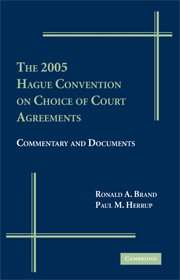Book contents
- Frontmatter
- Contents
- Preface
- PART I A BASIC INTRODUCTION TO THE 2005 HAGUE CHOICE OF COURT CONVENTION
- 1 The Context and History of the Hague Negotiations
- 2 The Convention Structure and Content
- 3 Interpretation and Use of the Convention
- PART II ARTICLE-BY-ARTICLE COMMENTARY ON THE CONVENTION
- PART III CHOICE OF COURT IN THE ABSENCE OF A MULTILATERAL CONVENTION
- PART IV LITIGATION AND ARBITRATION CHOICES AFTER THE HAGUE CONVENTION
- Appendix A Explanatory Report by Trevor Hartley & Masato Dogauchi (including the text of the 2005 Hague Convention on Choice of Court Agreements)
- Appendix B Cited Excerpts from the Nygh-Pocar Report
- Index
1 - The Context and History of the Hague Negotiations
from PART I - A BASIC INTRODUCTION TO THE 2005 HAGUE CHOICE OF COURT CONVENTION
Published online by Cambridge University Press: 26 October 2009
- Frontmatter
- Contents
- Preface
- PART I A BASIC INTRODUCTION TO THE 2005 HAGUE CHOICE OF COURT CONVENTION
- 1 The Context and History of the Hague Negotiations
- 2 The Convention Structure and Content
- 3 Interpretation and Use of the Convention
- PART II ARTICLE-BY-ARTICLE COMMENTARY ON THE CONVENTION
- PART III CHOICE OF COURT IN THE ABSENCE OF A MULTILATERAL CONVENTION
- PART IV LITIGATION AND ARBITRATION CHOICES AFTER THE HAGUE CONVENTION
- Appendix A Explanatory Report by Trevor Hartley & Masato Dogauchi (including the text of the 2005 Hague Convention on Choice of Court Agreements)
- Appendix B Cited Excerpts from the Nygh-Pocar Report
- Index
Summary
INTRODUCTION
The Hague Convention on Choice of Court Agreements [“the Convention”] requires that courts give effect both to agreements of the parties regarding the proper forum for settlement of disputes, and to the resulting judgments. The Convention is contained in the Final Act of the Twentieth Session of the Hague Conference on Private International Law, signed on June 30, 2005, and will affect both the planning of international commercial transactions and the process of dispute settlement in the resulting relationships. The Convention, in many ways, may serve as the litigation counterpart to the very successful United Nations Convention on the Recognition and Enforcement of Foreign Arbitral Awards (New York Convention).
This initial chapter provides context for consideration of the Convention. We first deal with the political-legal context, and then provide a history of both the legal issues and the process that led to the Convention.
THE CONTEXT OF THE HAGUE NEGOTIATIONS
Global trade, with its increase in the movement of people, goods, capital, services, and ideas across borders brings with it an increase in transnational disputes. In the absence of uniform legal rules of substance and practice, uncertainties abound in the resolution of these disputes. These uncertainties are reflected in party forum shopping and parallel proceedings, as well as in difficulties and expense in the recognition and enforcement of foreign judgments.
Problems of recognition and enforcement of home country judgments in foreign countries are of particular concern, especially for U.S. judgment creditors.
- Type
- Chapter
- Information
- The 2005 Hague Convention on Choice of Court AgreementsCommentary and Documents, pp. 3 - 10Publisher: Cambridge University PressPrint publication year: 2008

